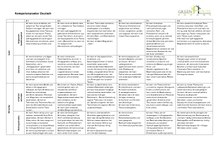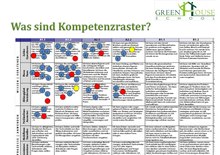Competence grid
A competency grid is a matrix of competencies to be acquired as part of a learning process on the one hand and different levels on the other.
It is an evaluation instrument and an instrument for self-control of the learning process by the learner. It can be used in all subjects.
construction
Differentiated competence descriptions form the basis of the grid. They explain which skills students will develop and develop over the course of the learning process . In addition to professional skills, these can also be social skills or information and presentation skills. Depending on the subject and the duration of the learning process, they can e.g. B. be defined for a half year or school year. The skills that a student to acquire the middle school leaving certificate or intermediate certificate needs to be some guidance in defining the different levels.
Competencies and skills to be acquired are entered along one of the axes. The classifications of the other axis represent different levels, from basic skills to complex requirements. In the individual fields of this matrix, learning and job descriptions are then entered that precisely represent the level in the corresponding category. "I can ..." formulations within the fields reinforce the learner's identification with their own progress.
With colors, notes or adhesive dots, the student can mark in his competence grid where he is in the learning process. He sees what he can already do and what he will be able to do if he continues to learn. The grid thus helps with self-assessment as well as planning the following learning steps and focuses. It is therefore also suitable as an instrument for individual advancement.
Use of competence grids in the classroom
- Competence grids have been used at the Beatenberg Institute for several years.
- At the Max-Brauer-Schule in Hamburg, the students work in the so-called learning office with competence grids.
- The Greenhouse School in Graal-Müritz, Mecklenburg-Western Pomerania, has been developing the work with competence grids for itself since it was founded in 2008 and has since implemented this as part of so-called "individual learning times".
literature
- Hagener, Tim: Competence Grid - Checklists - Weekly Plans: Introducing Individualization and Self-Regulation in Year 5 , in: Pädagogik 59 (2007), Issue 7–8, pp. 12–17
- Daniel Hunziker: Hocus-pocus competence - competence-oriented teaching and learning is not magic . hep-Verlag, Bern 2015, ISBN 978-3-0355-0640-2
- Merziger, Petra: Development of Self-Regulated Learning in Subject Lessons: Learning Diaries and Competence Grids in Upper Schools (Studies on Educational Research 14) Opladen 2007
- Müller, Andreas: Learning is a permanent construction site. Competence grid as work, self-management and evaluation tools , February 2003 ( Internet version: click on "Download the book« School can also be different »" Accessed on February 2, 2016.)
Web links
- Concept of the Greenhouse School, Graal-Müritz (PDF; 732 kB)
- Concept of the state study seminar Neuwied
- Link library for teachers: Competence grid / portfolio / individual feedback Collection of links to examples and handouts
Individual evidence
- ↑ www.institut-beatenberg.ch . Website of the Beatenberg Institute. Retrieved February 2, 2016.
- ^ Reinhard Kahl: New Max Brewer School . Archive of the future on Youtube Uploaded on December 7, 2007 (to work with competence grids from approx. 1:35 min. - 3:40 min.). Retrieved February 2, 2016.
- ↑ www.greenhouse-school.de . Website of the Greenhouse School, Graal-Müritz; unfortunately does not contain any information on the competency grids shown. Retrieved February 2, 2016

